What is Manchego?
Manchego is perhaps the most common sheep’s milk cheese available in the UK, perhaps the most reliable but also perhaps the most variable in quality.
It is a Spanish staple from the La Mancha region, made from milk from the Manchego breed of and carries its own PDO. Always in a drum format of about 1.5kg, it is available from many producers at many ages and many prices.
All Manchego’s are not equal, so knowing what you are buying is essential. It has been described as Spain’s cheddar and is ubiquitously available in supermarkets.
Matured sheep’s cheeses are characteristically sweet, nutty and dry, but some Manchegos are too young to do that. In cheese young is cheap, and supermarkets like cheap.
This post tells you what you need to know to make the right Manchego choice.
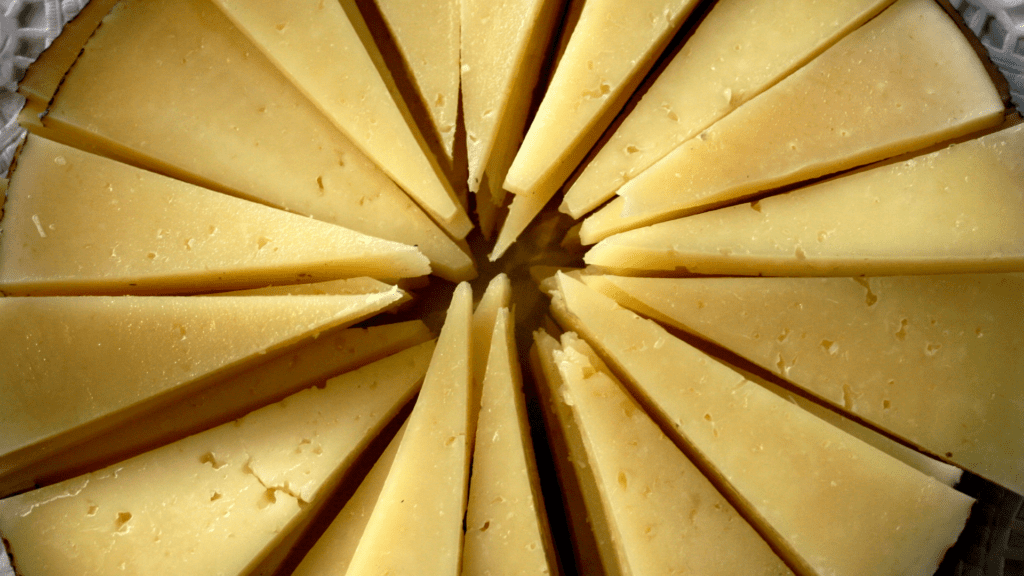
Why have Manchego on your table?
Here are six good reasons:
- It is delicious!
- The best producers are some of the best cheesemakers in Spain
- It is sheep’s milk and you need diversity on your cheeseboard
- Sheep’s milk cheeses are expensive, and relatively Manchego is good value
- Tapas is delicious, and you can’t have tapas without manchego
- It has a lot of distinctive characteristics, such as its pale paste, small holes, dark rind with the hatched patterning making it attractive for your cheeseboard
- Many people, perhaps you, are avoiding cow’s milk. Manchego is a great non-cow’s milk staple
Three facts that may be true:
- Cheesemaking in La Mancha from sheep’s milk dates back over 3000 years
- Miguel de Cervantes mentions it in Don Quixote of La Mancha.
- Manchego is higher in protein than meat
La Mancha, between Madrid and Alicante. The place is nearly a desert, it is a wonder something so delicious comes from such a sparse place.
Yes.
- Queso Manchego, Denominación de Origen (equivalent to a PDO).
- Queso Manchego Artesano, raw milk Queso Manchego and also covered by Denominación de Origen (called a DOP, equivalent to a PDO).
- North American Manchego
- South American Manchego
While it is interesting to know what they do on the other side of the Atlantic, we will be focussing on the original Spanish Manchego here.
The Spanish PDO Manchego has four recognised varietals. These, however, are not explicitly designated by the PDO, and are just in common usage.
- Fresco approx. 2 to 4 weeks or so (N.B. Tierno / Fresh cannot be Manchego PDO!)
- Semi-curado approx. 1 to 6 months
- Curado approx. 7 months to 12 months
- Viejo approx. 12 months or more
In my opinion, these are not tight enough to rely on when described by a vendor – producer, importer or retailer. I have seen different descriptions of what each means in different sources, often with an emphasis on making a cheese sound more mature and more tasty than perhaps it is.
However there are most definitely different stages in a manchego’s maturation, and the 4 ages are a valuable guide to buying and selling. I will be using these as we go forward, but I will be defining the stage by its character, not its age.
Manchego is up to 1.5kgs in weight, shaped as drum up to 22cm in width and 12cm tall. It feels hard, and in common with other Spanish and Portuguese cheese has a distinctive rind.

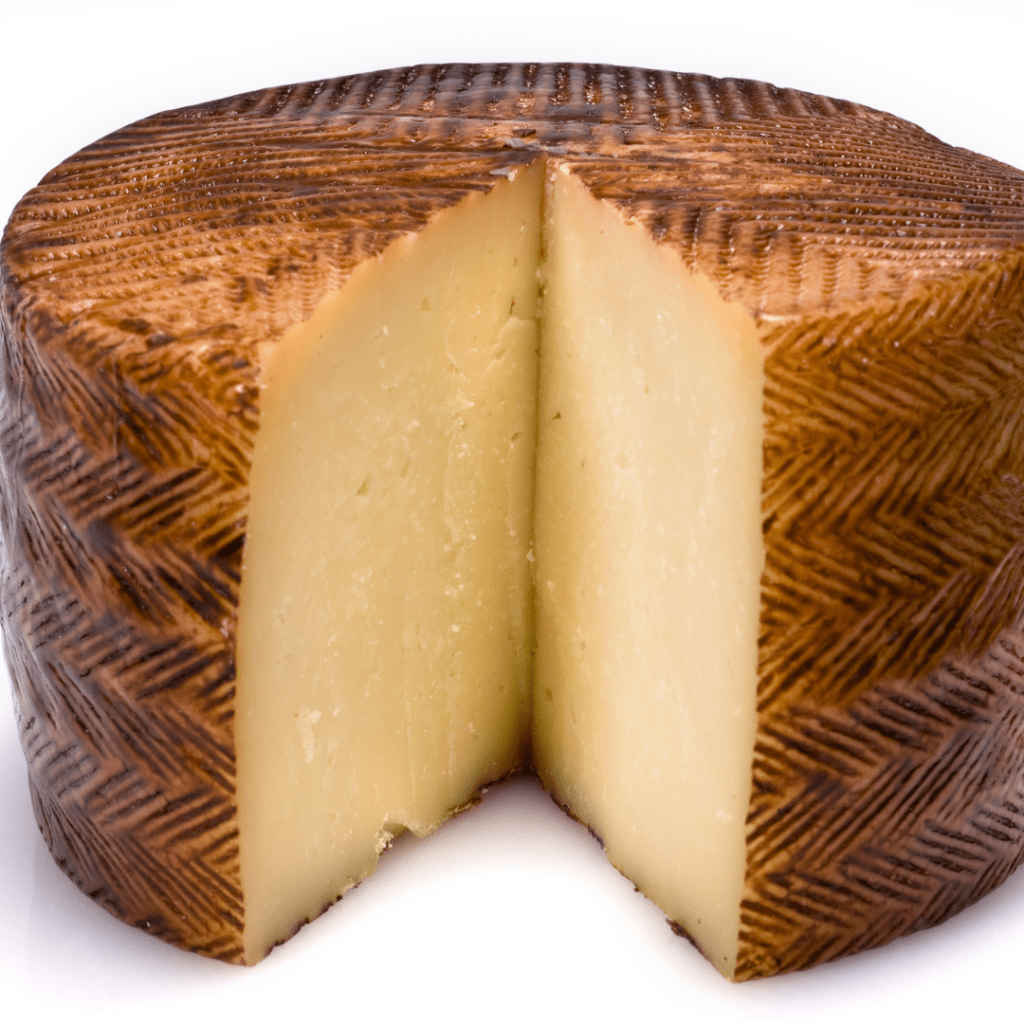
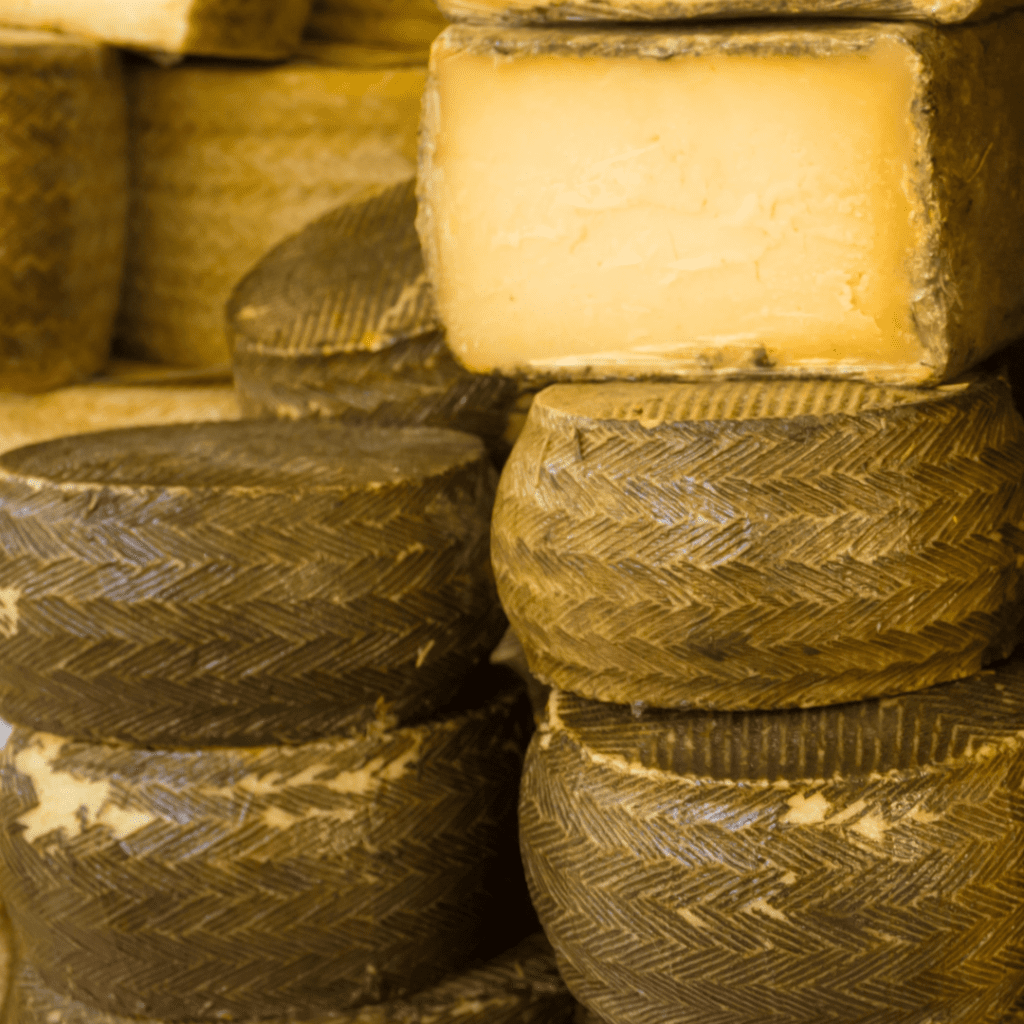
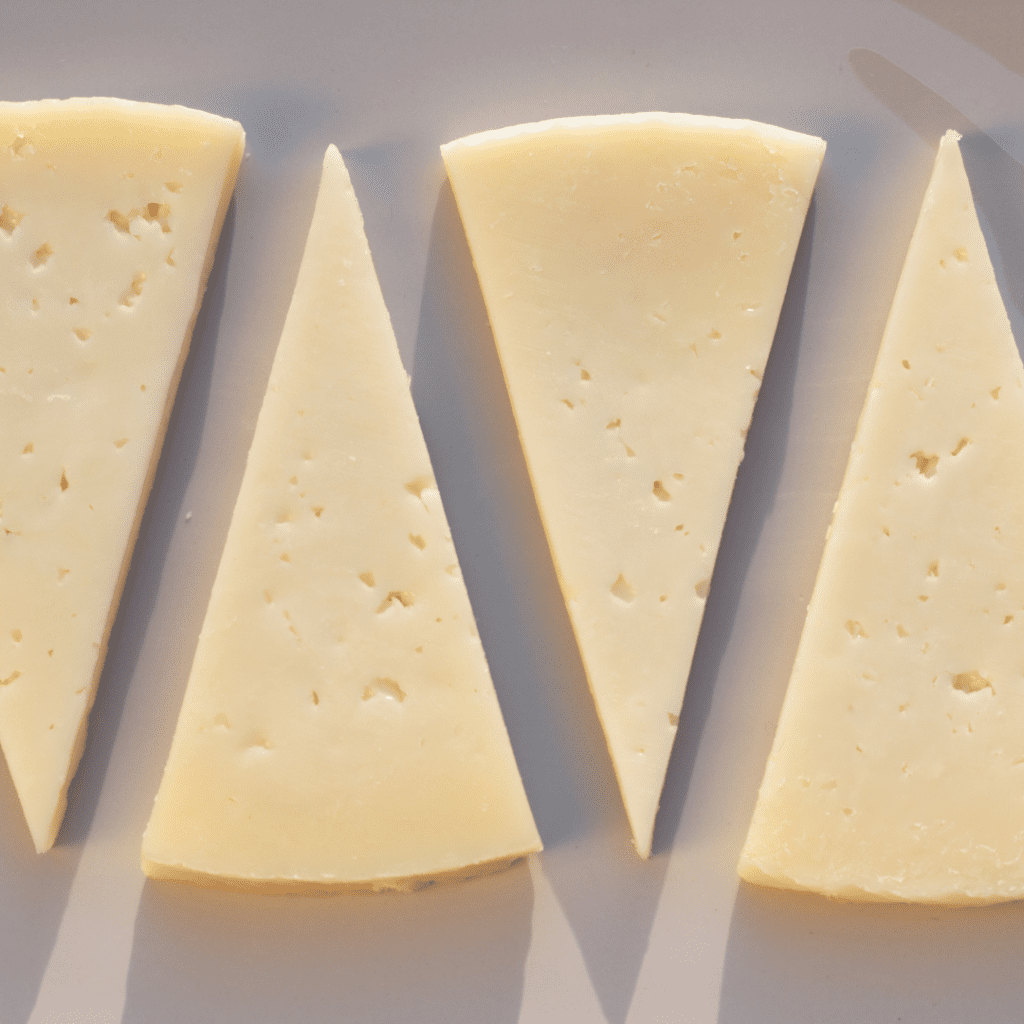
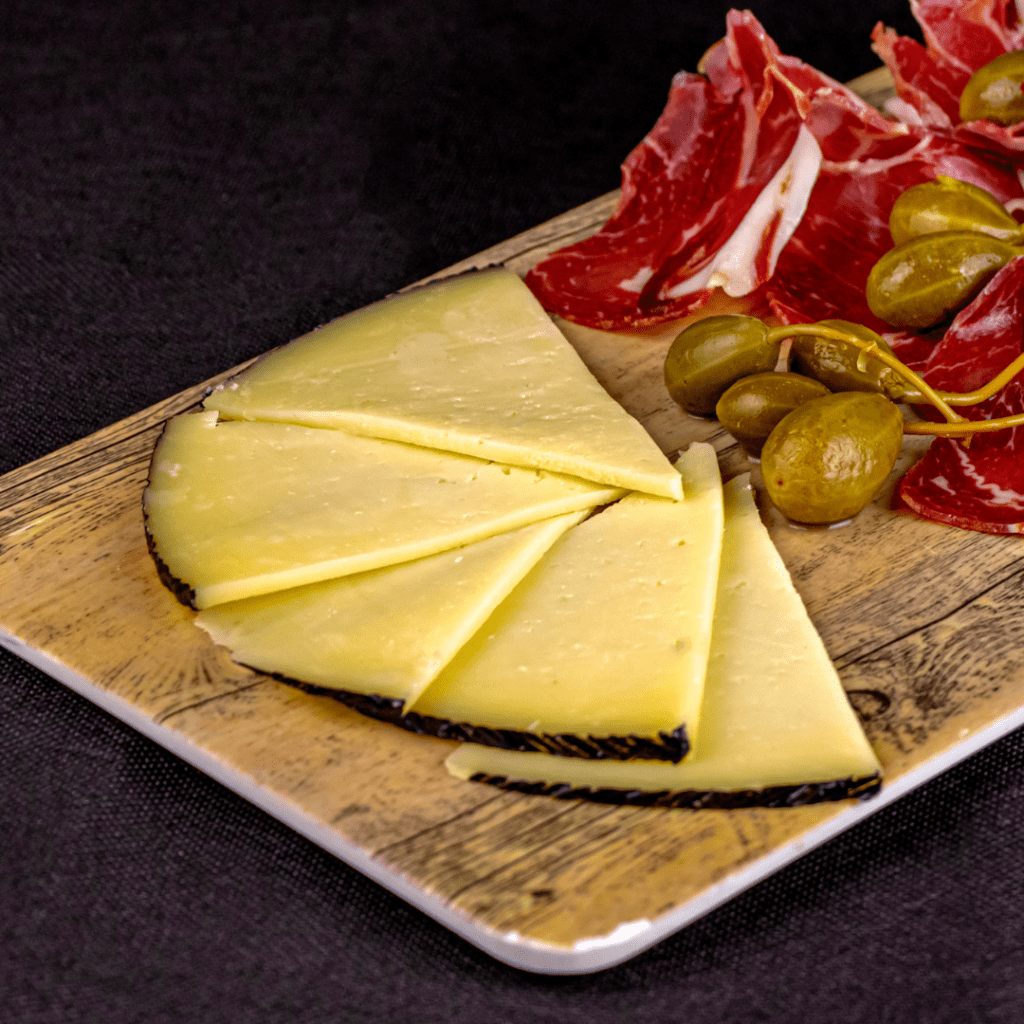
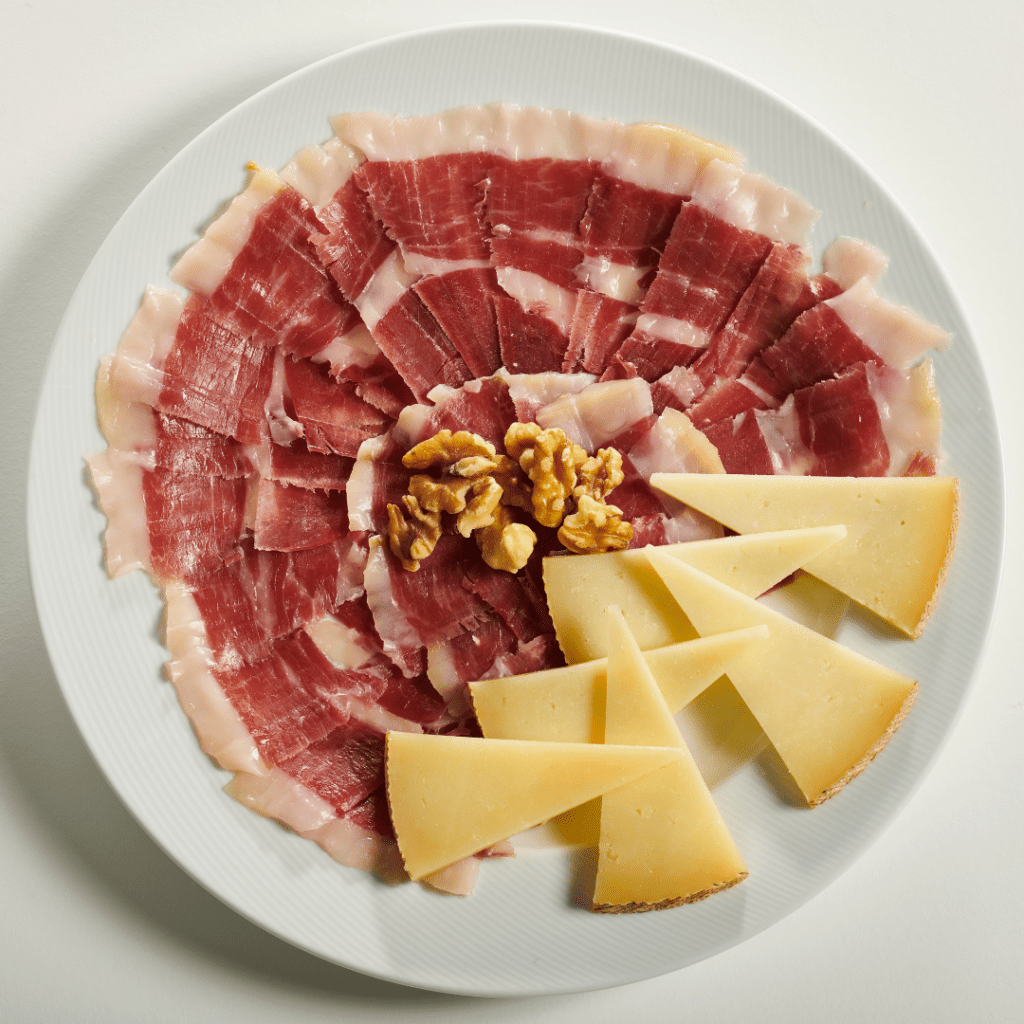
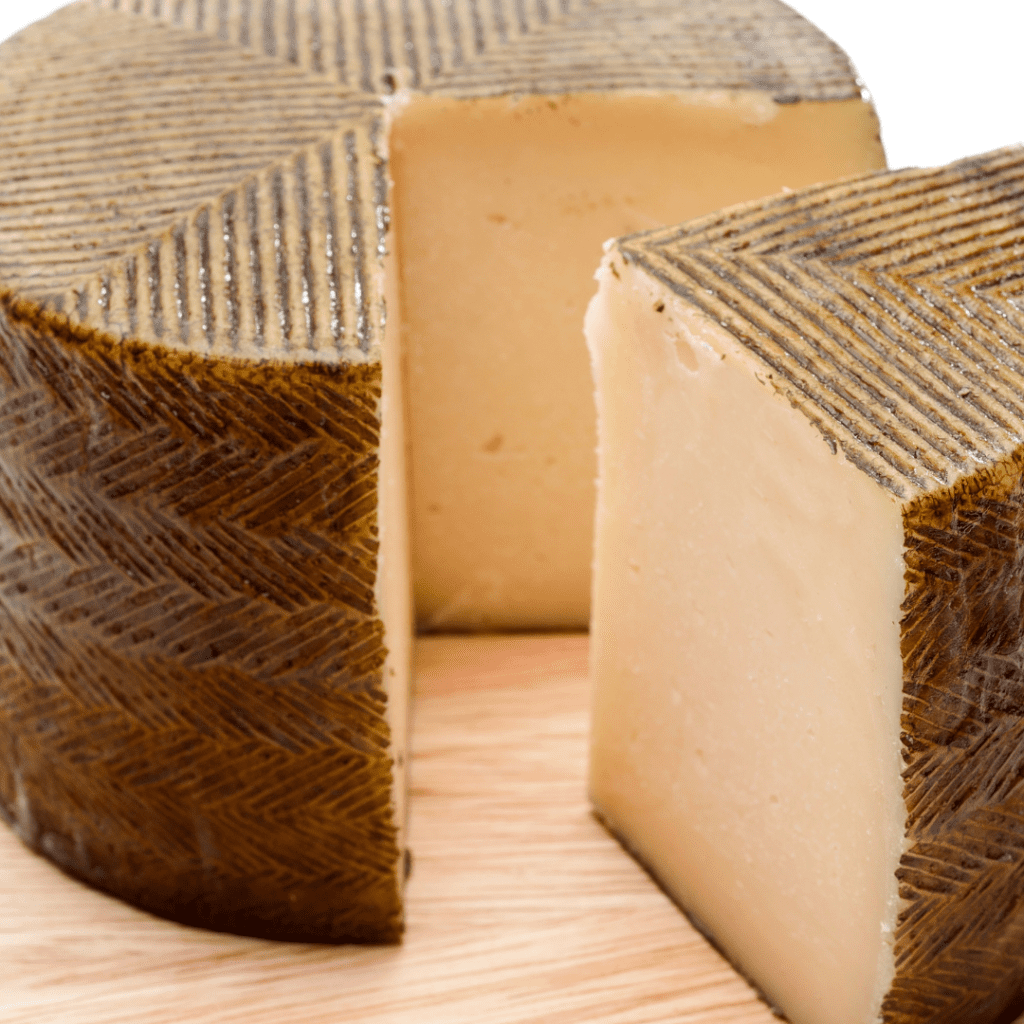

Paste
The paste of the cheese varies significantly over the life of the cheese:
- Fresco – rubbery and slightly squeaky. Look for: a clear curd structure and clean aroma
- Semi-curado – The paste has become elastic to firm, like a young gouda and there may be very small holes beginning to open up. The colour is white and will be gently rubbery when snapped or pressed. Look for: No blemishes and a milky aroma
- Curado – The cheese is now hard, with a significant number of evenly spread small holes. The colour is more ivory, with hints of amber towards the rind, sometimes with a translucency. Look for: No elasticity in texture, and even spread of holes, the beginning of translucency and dry smell
- Viejo – A hard rigid cheese with echoes of parmesan that has become difficult to cut. The holes will be clear, but may be fewer and larger in some cheeses. The curd now will be darker, amber with some (see-through) translucency. There may be veins of lighter curd in some places and occasionally hints of pink. Look for: Don’t judge on looks, these cheeses can be ugly. Go for a texture to suit your purpose and taste (see below)
Rind
Manchego rind has a platted grass or basket weave pattern, which appears like a tyre tread or tweed to the eye. Its origins are in the way manchego were formed before the use of plastic moulds, where a strap around 1.5m long and about 10-15cm tall was used as a griddle to shape the curd. The weave of the strap would leave an impression in the cheese and this has been carried over into plastic moulds now used by cheesemakers. Other cheeses that have this characteristic include Payoyo and Grazalema.
The rind is covered by a coating of plasti-coat, paraffin wax or olive oil which prevent the cheese from moulding internally during maturation. All three are allowed under the PDO. Olive oil and paraffin wax are more traditional, and you can get these from artisan importers in the UK. However the most common is plasti-coat, a spray-on-tan like varnish that seals the cheese during maturation. Plasti-coat is not poisonous and therefore edible, but not digestible.
Rind colouring varies from a straw or light khaki colour to dark brown wood stain. The darker stains are frequently painted or part of a coloured plasti-coat. I assume it is meant to imply greater maturity. I tend to become nervous about stained Manchegos, as it suggests to me at least a degree of marketing over substance. Assume that rind colour is not an indicator of quality or age.
Should you avoid plastic-coat cheeses? Plasti-coat is widely used, extremely effective and cheaper and less manual than oil or paraffin. I lean towards non-plasti-coat as more traditional, but I’m ok with it.
Should you eat the rind? No.
The below tasting notes are for a curado 9-month cheese.
Using the tasting notes:
- Paste applies to the body of the cheese
- Numbers range from 0-10, 10 being highest, 0 being not present
- Cheese can vary significantly in some areas, and number can vary. If you have anything you would like to add drop me a message
Before you taste the cheese…
| Texture/consistency | Paste | Rind | Comments |
| Texture | Hard: 6-7 | Hard: 7-8 | The rind is 4-6mm thick |
| Consistency | Firm and even, with small non-spherical eyes | Hard and even | |
| Blueing | None | None |
| Smell | Dry dairy/milky and grassy aroma, 4-5 |
When tasting the cheese
| Mouthfeel | Paste | Rind | Comments |
| Texture | Dry, firm, slightly granular and lightly oily | N/A | Common flaw: pappy weak body giving a floury or crumbly texture |
| Wet to dry | 6 – lightly drying | Common flaw: dry paste, requiring excessive chewing to open up the flavours |
| Simple flavours | Paste | Rind | Comments |
| Savoury | 5-7 | N/A | Secondary flavour |
| Sweet | Noticeably sweet 6-8 | Primary flavour | |
| Salt | 4-6 | ||
| Bitter | 0-1 | ||
| Acid | 1-3 |
| Complex Flavours | Likely | Occasional | Rare |
| Dairy | Butter 6-7; semi-skimmed milk 4- | cheddar 1-2; lactic 1-4 | Caramel 1-3 (more common in older cheeses |
| Fruity or Floral | Nutty* 4-7 | Walnut 1-5; almond 1-5; dried apricot 1-4 | |
| Vegetal or herbaceous | Dry grass 4-6; straw 2-3 | Yeast 1-3; malt 1-3; thistle 1-3; mustard seed or spice 1-2 | |
| Mineral or chemical | Cleaning fluid 1-2 (flaw) | ||
| Animal, fungal or fermented | Dry leather 1-2; farmyard 1-4 | Fermented tropical fruit 1-2 |
* Nutty is a common mis-tasting of when sweet and savoury are both high. It may be nutty, or just sweet and savoury. Ask yourself if you can identify a specific nut. Good Manchego’s will give real nut flavours, but it’s not essential to the enjoyment of Manchego
Overall assessment
| Complexity | Commonly 6-7, rare examples can go to 8 or 9 |
| Balance | 8 |
| Length | 7 |
| Summary | A nutty dry grassy buttery and slightly oily cheese, with tones of almond, walnut and hints of apricot. Firm in texture, and dry in the mouth, it has good balance and length. |
Lots of people and yes, very much. Manchego is a very big market and the variety of producers form creamery to fermier is substantial. It is also used in cooking which expands the volumes and quality even more. Plus, as described above, the ageing process has a significant impact on flavour.
Manchego, therefore, like cheddar, despite having a PDO is a catch-all that can be among the best and most boring of cheeses.
Manchego is a flexible cheese with a wide variety of uses. A rough rule of thumb:
- Fresco and semi-curado: cooking and as breakfast/lunch cheese
- Curado: cheeseboards and tapas
- Viejo: shaving, crumbles or grated – accents on cold or hot dishes
Sweet or savoury tracklement: Jelly, pickle or chutney?
Manchego is a sweet favouring cheese, so look for the sweet accompaniments including fruit cheese and honey.
The classic combination is with membrillo, Spanish for quince. In the UK it is called membrillo, or often quince cheese or quince paste, membrillo is a thick set jam usually shaped like a brick. Other fruit cheeses also go well.
White wines: I’m told oaked white rioja works well, and it sounds likely.
Red wines: Fruitier reds for the younger manchegos, spicier drier reds (such as rioja) for older cheeses.
Bitters: Not a predictable match
Lagers: Some Spanish lagers (note: lager is not a reliable friend to cheese)
Juices: Drier apple juices can go very well
Sherries: Stronger curado and viejo Manchego can be fantastic matches to both the dry and sweet sherries, so is well worth exploring. However the category is too broad to predict here. From a sales point of view go for a sherry that is enjoyable in its own right. For all the positive chatter about great sherries, too often they are insufficiently popular to hold their place on the shelves just to support manchego.
Ports: Port is surprisingly rarely a classic match as it tends to blend better with the British style dairy cheeses. However people still usually enjoy it.
Ciders: Ciders can make an excellent match if medium or dry. Spain has some truly wonderful ciders, especially on the northern Bay of Biscay coastline – check them out just for run.
The Environmental rules are that you can leave it out of the fridge for 2 hours, and then return it to the fridge for normal use. You can leave it out of the fridge between 2 and 4 hours, and then it must be consumed or disposed of. This is very limiting, and most ordinary people are either not aware of the rules or ignore them.
However, anybody who has been to Spain, a far hotter country than ours, knows they leave their Manchego’s out in a very relaxed fashion
Storage
- Number 1 choice – In your fridge: I use a Tupperware, and am quite happy putting all my cheeses together, unwrapped and even touching when I have a lot of cheeses in the house. The exception is the washed rind cheeses. These don’t play well with others and should have their own box.
Why doesn’t the white or blue mould get into other cheeses? Given enough time it will, but you’ve got a week. just keep eating your cheese at a good rate. - Number 2 choice – Clingfilm: it really works, keeps the air out and is less harmful on the environment than bagging them up
Storage DONTs
- I don’t like greaseproof paper. It is generally not recyclable nor proof from cheese drying out, and once used two or three times becomes dirty and a hazard. I agree it looks cool, but cheese looks best naked anyway.
- Tinfoil: some blue cheeses use it but it is not the same as the stuff you buy in supermarkets. It has a plastic coating on the cheese side. Don’t use your own.
Bring to room temperature before consuming, this means 20-23oC in most houses. An hour should be plenty for wedges, for large pieces leave a little longer.
Charlie’s top tips: How to buy a good piece of Manchego
Here are my two golden rules:
- Always taste before you buy (if you can)
All cheeses are affected by their whole journey, not just who made them. The season of making, the weather on the day, who by and how they were matured, how long they will in the chill chain (chilled transport system) for. - Buy your wedge cut off from a big cheese (if you can)
All cheeses like to stay whole as long as possible to keep their moisture levels right and avoid packaging damage such as pickling and vac pack pressing.
Is Manchego suitable for pregnant and immunity fragile people?
I always point to the British NHS guidelines as they are trusted by a lot more people than me. But it if you do want to know my view, Semi-curado, curado and viejo Manchego are all ok as being hard cheeses tat can not support listeria, the main risk in this context.
Have I missed anything?
If you have suggestions about this post, know of any other producers or alternatives comment somewhere on the socials.





2 responses
Hi Charlie,
I just see, that there is one important point missing in your article, and I probably made the confusion even greater.
The times for maturing I added is not from the PDO Regulatory Council but from the Spanish Government and applies to ANY type of cheese produced in Spain.
The PDO Manchego does not define any specific times beyond those of the Spanish Government.
BUT it defines the MINIMUM TIME FOR MATURING, being 30 days for those smaller than 1,5 kg (uncut) and 60 days for thos above 1,5 kg (uncut)
In general, a typical 3 kg Manchego PDO should have a minimum of 60 days.
I have seen in the UK younger cheese branded as Manchego which are clearly a FAKE! They have the casein plate and the round yellow DOP stamp, but there is no anagram with a serial number in them, which is the only sign that is truly applied by the Regulatory Council and not self-declared by the producer.
This is really an important point.
For any doubts on this, do not hesitate in calling me.
P.S.
The only cheese that can be legally called Manchego, and is not certified by the CRDO (Regulatory Council) is the Mexican Manchego – and as far as I know only in Mexico.
Anything that is not certified by the CRDO Manchego Cheese and states Manchego can be denounced, and the CRDO will advice them to withdraw the product from the market. It goes even further. You can neither use any symbolism or wording that may induce confusion.
This happend recently to one of our producer in La Mancha who used the iconography of a horse with a man and a stick – that looked very much like a Don Quixote. They were 2 years in court fighting and lost against the CRDO. They had to take all their products from the shelf.
So far, controls where quite lax, but they will increase.
In my personal opinion, beyond the legal aspect, I consider it simply pure marketing. In Spain there are 26 types of cheese with Protected Denomination of Origin. Besides this, there are great cheese without PDO. At Sanabria Cheese we produce Iberico, Sheep and goat cheese and mixed-milk cheeses which are as delicious as the Manchego.
That’s like calling a Porsche, Lamburguini – why would you do that?
But consumers should not be cheeted. If you want to support our rural communities and ecosystem, buy real Manchego.
And if you like the specific and unique taste of Manchego, now, you know what to look for.
Thanks, Tabea. I have added an amendment to include the fact that Tierno / Fresh cannot be Manchego PDO! – Your input is much appreciated.